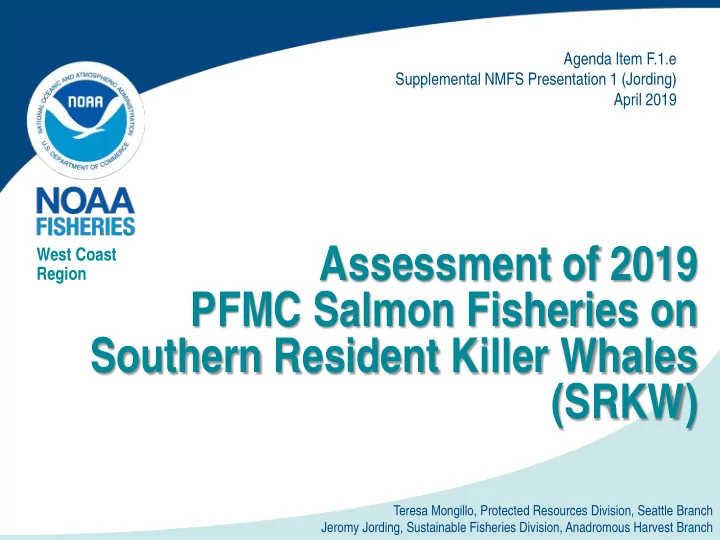

Agenda Item F.1.e Supplemental NMFS Presentation 1 (Jording) April 2019 Assessment of 2019 West Coast Region PFMC Salmon Fisheries on Southern Resident Killer Whales (SRKW) Teresa Mongillo, Protected Resources Division, Seattle Branch Jeromy Jording, Sustainable Fisheries Division, Anadromous Harvest Branch
Progress review NMFS issued guidance relative to SRKW in March 2019 (Agenda Item D.1.a) West Coast Region Guidance: • Re-initiation • Reassess effects • Consider priority stocks U.S. Department of Commerce | National Oceanic and Atmospheric Administration | NFMS | Page 2
2019 Analysis • Council instructed Salmon Technical Team (STT) to work with NMFS to crosswalk FMP stocks with the list of priority Chinook prey stocks at the March 2019 meeting. (Agenda Item D.8.a, Rpt 2) • NMFS used the STT’s report to crosswalk information on priority stock abundance and contribution to Council fishery catch. U.S. Department of Commerce | National Oceanic and Atmospheric Administration | NMFS | Page 3
2019 Analysis • NMFS first used methods described in the 2009 biological opinion to evaluate the percent reduction of prey available to SRKW due to Council salmon West Coast fisheries. Region • Updates to the FRAM base-period since 2009 provide a more contemporary assessment. • The results on the following slide present this assessment using the 2019 March alternatives, which NMFS preliminarily updated with expectations for northern fisheries and stock abundances in late March. U.S. Department of Commerce | National Oceanic and Atmospheric Administration | NMFS | Page 4
Results • We calculated % reductions for the three 2019 Alternatives. 2019 PFMC Fishery % Reduction Scenario Winter Spring Summer Alt1: 0.6% 4.7% 9.9% Alt2: 0.4% 3.9% 8.7% Alt3: 0.4% 2.8% 7.1% • Compared to observed % reductions in past. • Percent reductions in the spring FRAM timestep 1992-2016 % and summer are below the Reductions Winter Spring Summer median for all three Lower Quartile: 0.3% 3.4% 7.9% alternatives. Median: 0.5% 5.4% 13.9% • Fisheries occurring in the winter Upper Quartile: 0.9% 8.4% 19.0% time step were planned in 2018 U.S. Department of Commerce | National Oceanic and Atmospheric Administration | NMFS | Page 5
Results FMP stocks translated to Priority Stock groups • 2019 forecasts translated into priority stock composition fall within a middle range when compared to baseline conditions U.S. Department of Commerce | National Oceanic and Atmospheric Administration | NMFS | Page 6
Results • The 2019 overall forecasts composition contains a higher proportion of stocks that have higher priority scores 1992-2016 Average 2019 Preseason West Coast Region U.S. Department of Commerce | National Oceanic and Atmospheric Administration | NMFS | Page 7
Results • Evaluated contribution of priority Chinook stocks to total Council area Chinook salmon harvest retrospectively • Compared to 2019 alternatives Photo by Marilyn & Eric Jordan 100% U.S. Department of Commerce | National Oceanic and Atmospheric Administration | NMFS | Page 8
Summary West Coast Region Conclusion NMFS does not anticipate the 2019 Council fisheries would contribute at an unacceptable level to conditions that pose a risk to SRKW recovery. U.S. Department of Commerce | National Oceanic and Atmospheric Administration | NMFS | Page 9
Questions? West Coast Region U.S. Department of Commerce | National Oceanic and Atmospheric Administration | NMFS | Page 10
Recommend
More recommend